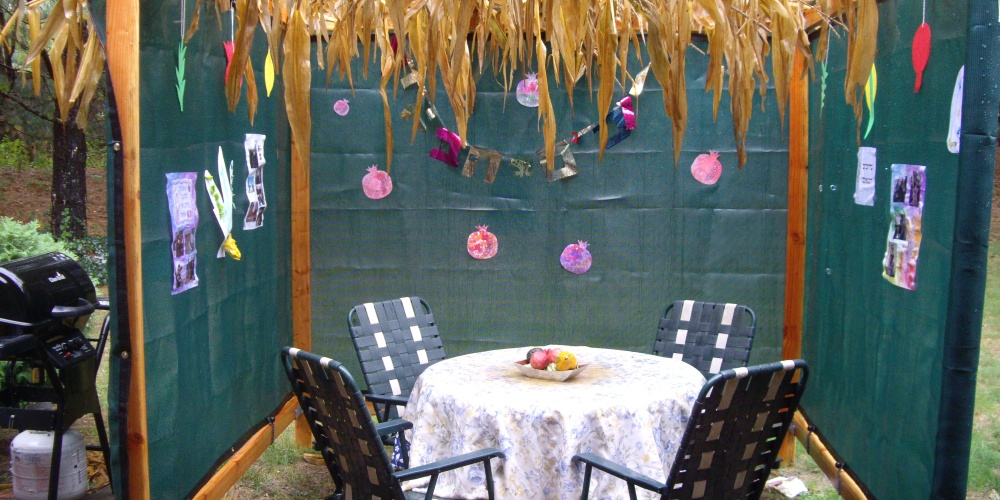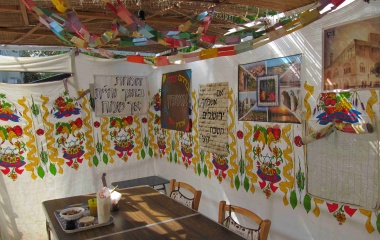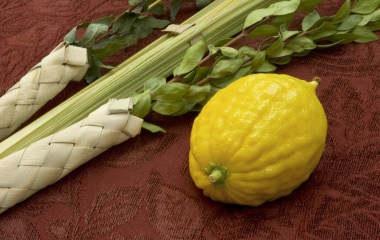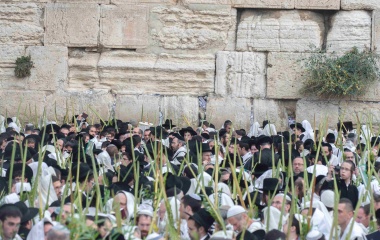
We eat matza on Pesach to commemorate the matza eaten by our ancestors as slaves in Egypt and as newly freed people. The blowing of the shofar on Rosh Hashanah parallels the mitzva to blow shofar on many an occasion (see Bamidbar, chapter 10). We light the menorah on Chanukah to commemorate the lighting of such in the Temple. The partying that accompanies Purim can be traced to the many parties in the Megillah. Even our fasting on Yom Kippur can be traced to the fasting of Moshe on Har Sinai.
However, it is not at all clear that our Sukkot commemorates the actual dwelling in sukkot. "You shall dwell in booths seven days; all the citizens of Israel shall dwell in booths; l'ma'an yedu, so that your generations will know that I made the children of Israel to dwell in booths, when I brought them out of the land of Egypt" (Vayikra 23:42-43). "Sukkot--these are the clouds of glory, [these are] the words of Rabbi Eliezer; Rabbi Akiva says actual sukkot" (Sukkah 11b). According to Rabbi Eliezer, the mitzvah to dwell in a sukkah is a symbolic one, commemorating G-d's protective cover for the Jewish people as He redeemed us from Egypt and led us in the desert.
Being that our sukkah is "only" symbolic, unless one understands the message behind such symbolism one cannot properly fulfill the mitzvah[1][2]. Thus, the Tur, in his monumental 14th-century code of Jewish law (Orach Chaim #625), rules that we follow the view of Rabbi Eliezer; our Sukkah is a representation of the clouds of glory, and when one sits in a sukkah, one must be cognizant of G-d's protection.
Knowledge of the purpose of the Sukkah is the reason given by Rava to explain why a sukkah above twenty cubits is invalid (Sukkah 2a). At that height, one may not even realize that one is sitting in a sukkah, let alone that the sukkah reminds us of the protective cover of G-d.
Further symbolism can be seen in the two other reasons the Sages invalidated such a tall sukkah. "And the sukkah shall be for shade in the daytime from the heat, and for a refuge and for a cover from storm and from rain" (Isaiah 4:6). The sukkah teaches that, despite the efforts of man, only G-d can provide complete refuge. When one sits a in sukkah over twenty cubits high, the shade comes from the walls, symbolizing the efforts of man--and not from the s'chach[3], symbolizing G-d's protection from above.
The sukkah is a temporary structure. This is the reason Rava teaches that a sukkah must be less than twenty cubits high. A taller structure cannot be considered temporary and hence, is invalid.
The temporary nature of the sukkah reflects the temporary nature of life. The oft-times inverted nature of man's priorities can be seen in the sukkah itself. The s'chach, that which makes the sukkah valid, consists of "the leftovers of the threshing floor and the winepress" (Sukkah 12a). Caught up in aspects of life that are all too often of a fleeting nature, we may fail to realize that which we dispose of is often the most valuable. And that is something to think about as we sit in the sukkah.
[1] The eating of matza, to use one simple example, commemorates actual historic eating of matza; and thus, it is not essential (though it is advisable) to fully understand why we eat the matza.
[2] The Bach, in his commentary to the Tur, notes a similar concept regarding the mitzvoth of tzizit and tefillin. Here, too, the mitzvoth are symbolic, and the Torah explains the mitzva with the use of the word "l'ma'an". We wear tzizit "l'ma'an tizcheru, so that you may remember and do all My commandments, and be holy unto your God (Bamidbar 15:43). Our tefillin "shall be for a sign unto thee upon thy hand, and for a memorial between thine eyes, l'ma'an, so that the Torah of G-d will be on our lips (Shemot 13:9). Whether there is any significance in the fact that these three mitzvoth, all symbolic in nature, are mitzvoth in which women are exempt may be worthy of further exploration.
[3] The Talmud notes that the source of the shade is dependent on the relationship between the length, width, and height of the sukkah; and thus, if the sukkah is greater than four by four cubits, it will be valid even beyond twenty cubits' height. Tosafot is uncertain as to whether the increased area must be proportionate to the increase in height, or if once a sukkah is greater than four by four cubits then any height would be acceptable. This Tosafot claims is because it's impossible for an area greater than four by four cubits not to receive some shade from the roof regardless of how high the roof may be. Any enlightenment from the scientists reading this would be appreciated.



